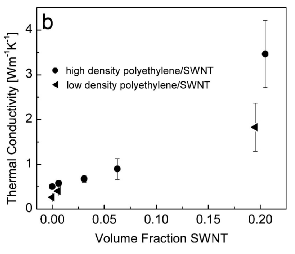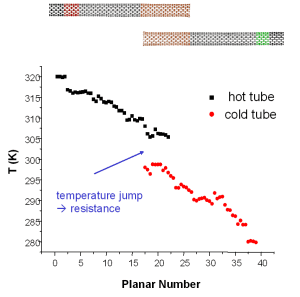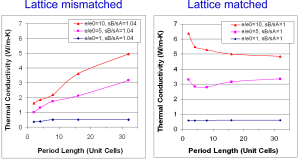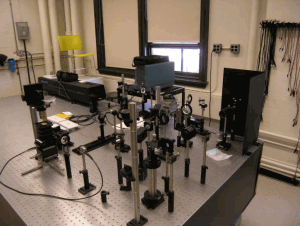Emergent Behavior of Thermally Coupled Nanostructures
(Funding: Office
of Naval Research , National Science
Foundation CAREER Award )
A primary research focus of our group is the emergent thermal
transport behavior of nanostructures configured in complex
arrays, systems spanning multiple length scales, and
nanocomposite materials. A key
goal of this research is to develop experimentally validated simulation methodologies to couple disparate length scales. Work in this area includes
the following projects:
| |
|
Nanocomposites for Improved Thermal Conductivity |
| |
 In this project, we have investigated the thermal
conductivity of polymer-carbon nanotube composite materials
with an aim toward developing better materials for enhanced
heat removal from high temperature electronics. Our results
indicate that thermal conduction in the composites occurs
through percolation, and suggest the intriguing possibility
that thermal resistances in the system are dramatically
reduced by polyethylene crystallites that nucleate at carbon
nanotube surfaces and bridge adjacent nanotubes.
In this project, we have investigated the thermal
conductivity of polymer-carbon nanotube composite materials
with an aim toward developing better materials for enhanced
heat removal from high temperature electronics. Our results
indicate that thermal conduction in the composites occurs
through percolation, and suggest the intriguing possibility
that thermal resistances in the system are dramatically
reduced by polyethylene crystallites that nucleate at carbon
nanotube surfaces and bridge adjacent nanotubes.
|
| |
| |
|
Interfacial Thermal Resistance between Carbon Nanotubes
|
| |
| |
 We have investigated the length, spacing, and overlap
dependence of thermal interfacial resistance between carbon
nanotubes. Interestingly, our studies have found that thermal
tunneling between the nanotubes across a vacuum gap can
occur even at large spacings due to intermittent thermal
fluctuations that drive atoms in neighboring nanotubes toward
each other.
We have investigated the length, spacing, and overlap
dependence of thermal interfacial resistance between carbon
nanotubes. Interestingly, our studies have found that thermal
tunneling between the nanotubes across a vacuum gap can
occur even at large spacings due to intermittent thermal
fluctuations that drive atoms in neighboring nanotubes toward
each other.
|
| |
| |
|
Superlattice Thermal Transport
|
| |
| |
 We have investigated the thermal transport characteristics of
superlattices and superlattice nanowires. The major
accomplishment of this research was the identification of
interfacial strain as a key factor influencing thermal
transport. For example, we found that interfacial strain
causes superlattice minimum conductivity to vanish. Also,
we found that thermal resistance at individual interfaces in
superlattice nanowires increased with increasing superlattice
period due to pronounced strain variation across the
interfacial region.
We have investigated the thermal transport characteristics of
superlattices and superlattice nanowires. The major
accomplishment of this research was the identification of
interfacial strain as a key factor influencing thermal
transport. For example, we found that interfacial strain
causes superlattice minimum conductivity to vanish. Also,
we found that thermal resistance at individual interfaces in
superlattice nanowires increased with increasing superlattice
period due to pronounced strain variation across the
interfacial region.
|
| |
| |
| |
|
Modulated Thermoreflectance Thermal Transport Measurements
|
| |
 We have established a modulated thermoreflectance laser
setup for thermal conductivity measurements of nanostructured
(and other) materials. In the
experiment, a modulated laser beam is used to heat the
sample, and a second, continuous laser beam is used to probe
the resultant reflectivity variation. The amplitude and
phase of the measured reflectivity signal are used, in
conjunction with an analytical model, to determine thermal
conductivity. Additionally, the setup has a scanning
capability for nondestructive structural evaluation.
We have established a modulated thermoreflectance laser
setup for thermal conductivity measurements of nanostructured
(and other) materials. In the
experiment, a modulated laser beam is used to heat the
sample, and a second, continuous laser beam is used to probe
the resultant reflectivity variation. The amplitude and
phase of the measured reflectivity signal are used, in
conjunction with an analytical model, to determine thermal
conductivity. Additionally, the setup has a scanning
capability for nondestructive structural evaluation.
|
| |
| |
|
Relevant Publications
|
| |
| R. Haggenmueller, C. Guthy,
J. R. Lukes, J. E. Fischer, and K. I. Winey, 2007,
Single Wall Carbon Nanotube/Polyethylene
Nanocomposites. Thermal and Electrical
Conductivity, Macromolecules, Vol. 40,
pp. 2417-2421.
|
| |
| H. Zhong and J. R. Lukes, 2006,
Interfacial Thermal Resistance between Carbon
Nanotubes: Molecular Dynamics Simulations and
Analytical Thermal Modeling, Physical Review B,
Vol. 74, 125403. (Selected for the September 18,
2006 issue of Virtual Journal of Nanoscale Science and
Technology)
|
| |
| Y. Chen, D. Li, J. R. Lukes, Z. Ni,
and M. Chen, 2005,
Minimum Superlattice Thermal Conductivity from
Molecular Dynamics, Physical Review B,
Vol. 72, 174302. (Selected for the November 21,
2005 issue of Virtual Journal of Nanoscale Science and
Technology)
|
| |
| Y. Chen, D. Li, J. Yang, Y. Wu,
J. R. Lukes, and A. Majumdar, 2004,
Molecular Dynamics Study of the Lattice Thermal
Conductivity of Kr/Ar Superlattice Nanowires,
Physica B, Vol. 349, pp. 270-280.
|
| |
| Y. Chen, D. Li, J. Yang, Z. Ni, and
J. R. Lukes, 2004,
Interface Effect on Lattice Thermal Conductivities of
Superlattice Nanowires,
Proceedings of the 2004 International Mechanical
Engineering Congress and Exposition, November 13-20,
2004, Anaheim,
California, IMECE2004-59149.
|
| |
|